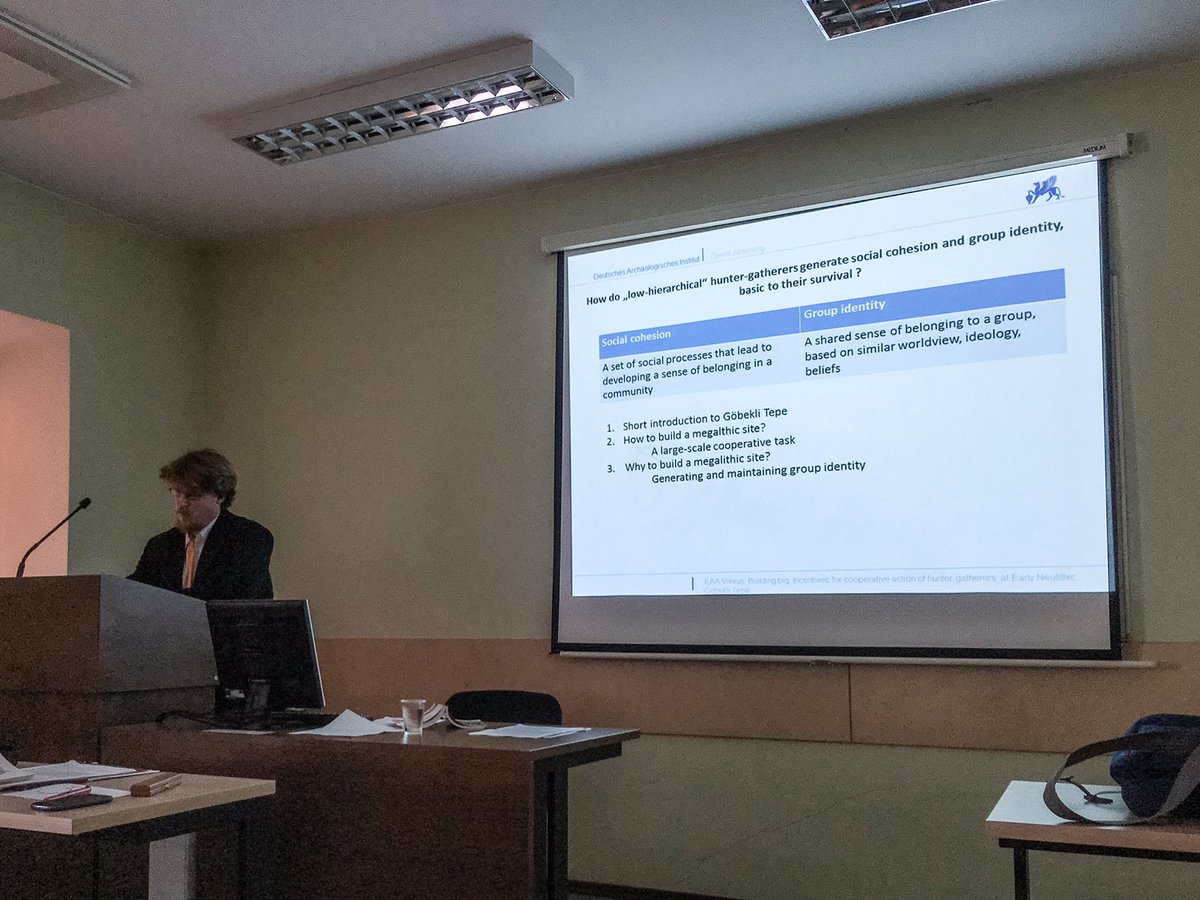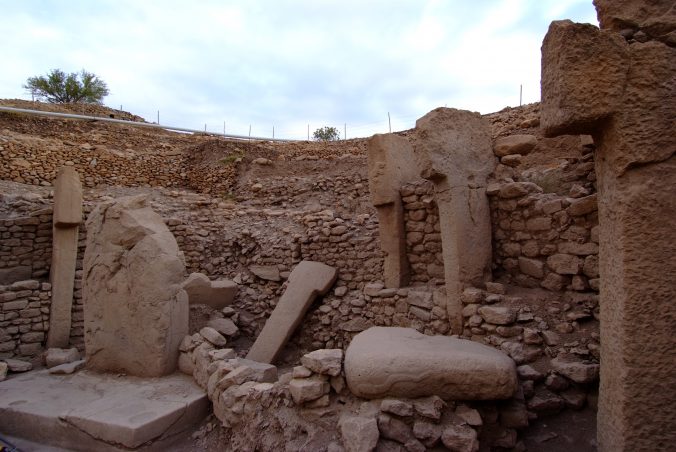Back in the office from a very pleasant and thought-provoking EAA Annual Meeting in Vilnius, where an intriguing session [external link] on the concept of social cohesion in archaeology was organised by Laura Dietrich and Agnė Čivilytė. As publication of the contributions may take some time, here is a (very) short version of my talk on Göbekli Tepe.

Impression from EAA Vilnius (Photo J. Notroff).
The core question of the talk was how „low-hierarchical“ hunter-gatherers were able to generate and maintain social cohesion and group identity basic to their survival. By social cohesion I mean a set of social processes that lead to developing a sense of belonging in a community, while group identity is a shared sense of belonging to a group, based on similar worldview, ideology, and beliefs. Both concepts are obviously interrelated, but not the same.
So, how to gather people to build a megalithic site?
If we look at ethnography, we immediately find a wide range of examples not unlike the description of the transport of a megalith on Nias, with 525 people hauling it in 3 days over a distance of 3 km to the construction site of a grave (Röder 1944). Such examples have to be set in a social perspective however, as for example on Nias the number of people involved reflects the status of the builder, who will spent lots of resources to attract as many as possible (Notroff et al. 2014). We thus should not overemphasize such examples for purely technical calculations of the necessary manpower, but better have a look at the archaeological evidence first.
At Göbekli Tepe, the Neolithic quarry areas from which the workpieces for the enclosures originate are well known. They lie on the limestone plateau immediately adjacent to the site. The maximum distances that had to be covered were 600-700m. However, the terrain is uneven and sloping upwards, and the megaliths are of impressive size.
The largest standing pillars discovered so far have 5.5m and weigh around 10t. In the quarry areas however there is one example of a 7 m long pillar preserved. It also shows the chaine operatoire involved in carving a megalith out of the bedrock [read more]. A channel was dug in the form of the desired workpiece. The limestone surrounding Göbekli Tepe is banked, strata of about 0.60 – 1.50 m thickness are divided by fault lines. This means that you just have to dig around a work piece, not also beneath it. Then the megalith had to be lifted, transported to the construction site, finished and decorated. The amount of work included in this process seems pretty high.
Another aspect is adding in here. It seems that the enclosures were never really finished. There is permanent construction, deconstruction, and reconstruction activity at Göbekli Tepe, and the intensity of work indicates something else than pure maintenance. Most likely the act of working at the site was central to the builders, and repeated periodically, whether or not a real need existed. For example, in the inner ring of Enclosure C there is barely one pillar standing in its original position.

Enclosure C was subject to massive re-arrangement during the PPN (Photo N. Becker, copyright DAI).
As Göbekli Tepe has no traces of settlement, there is no possibility of a direct evaluation of the number of people present on-site. If we turn to ethnographic data, core group sizes of 25-50 persons for fully mobile hunter-gatherers, and a little higher numbers for semi-sedentary residential groups are suggested. The number of people one group could spare for construction work of the amplitude visible at Göbekli Tepe is definitely too small. It seems possible that several groups had to collaborate for a period of time to carry out building activities and to supply for the builders. And there actually is vast evidence for people from a catchment area of roughly 200km around the site congregating at Göbekli Tepe [read more].
An answer to the question why these people congregated for work at Göbekli Tepe comes from the enclosure´s fillings. The material used as backfill consists of limestone rubble from the quarries nearby, flint artefacts and animal bones smashed to get to the marrow, clearly the remains of meals. Enclosure D alone, the largest of the four circles, comprised nearly 500 cubic meters of debris. With traces of permanent settlement absent, for Göbekli Tepe this readily leads to the idea of large, ritualized work feasts rooted in the belief systems of the people congregating there. This concept was explored in-depth by Dietler and Hayden and provides a good working hypothesis to explain the at least temporary supra-group cohesion generated for collective work. But of course that would not be the only occassions where people gathered at the site. Ritual activities would likely include minor feasts, with less people present, maybe even restricted to certain groups.
The enclosures excavated so far show a variation in the animal species depicted prominently in the iconography of each circle, and distinct enclosures may have served different social entities [read more]. The character of these entities remains open to discussion at the moment. There are some clues however. Restriction of the access to knowledge and participation in rituals seems to be attestable at Göbekli Tepe. On a general level, some object classes known from settlements are missing. For example, awls and points of bone are nearly completely absent. The tasks carried out with them probably were not practiced here, and it may well be that the part of the population carrying them out was absent, too. Further, clay figurines are absent completely from Göbekli. This observation gains importance in comparison to Nevalı Çori, where clay figurines are abundant, missing only in the ‘cult building’ with its stone sculptures and T-shaped pillars very similar to Göbekli Tepe. Clay and stone sculptures may thus well form two different functional groups, one connected to domestic space (and cult?) and one to the specialized ‘cult buildings’ – and to another sphere of ritual also evident at Göbekli Tepe. Its iconography is exclusively male.

The western broadside of Pillar 43 in Enclosure D ist decorated completely with a variety of motifs (Photo O. Dietrich).
As already shown, the pillars are often richly decorated. But in some cases, the imagery obviously is going far beyond mere decoration. The narrative character of several depictions in flat relief is underlined by Pillar 43, whose whole western broad side is covered by a variety of motifs. This could be a hint to one aspect of the enclosure´s functions – as a repository for tales, maybe myths crucially important to the groups building them.
It is also possible to identify the general theme these stories – and the enclosures – are related to. A recurring motif on reliefs is human heads between animals, or, as already seen on pillar 43, headless humans. The special treatment and the removal of skulls is well-attested for the PPN death ritual [read more]. A connection with death or ancestor cult of Neolithic groups seems to be the most probable function of Göbekli Tepe´s enclosures. With their rich decoration, they are monuments in stone of important aspects of these groups identities, which were reinforced during ritually repeated events that included feasting.
To sum up, it seems that at Göbekli Tepe we see two social phenomena interact. Constant building activity generated a need for cooperation that was met by large work feasts that produced social cohesion. However, there are further social practises attestable that generate cohesion. The monuments served to memorize crucial knowledge, and, together with ritual performances that probably included smaller feasting events, to reaffirm group identity. The character of these groups remains unclear at the moment. Whether we are dealing with single clans, the male hunters of certain settlements, or secret societies as the users of the enclosures remains to be seen in the future.
Bibliography
Notroff, J., Dietrich, O., Schmidt, K., Building Monuments – Creating Communities. Early monumental architecture at Pre-Pottery Neolithic Göbekli Tepe. In: James Osborne (ed.), Approaching Monumentality in the Archaeological Record. Albany: SUNY Press (2014), 83-105.
Röder, J., Bilder zum Megalithentransport. Paideuma – Mitteilungen zur Kulturkunde, III 1-2 April 1944, 84-87.

Please could you identify the motifs on pillar 43. The topmost shapes are particularly intriguing.
Please have a look here for more information on P43: http://www.exoriente.org/docs/00066.pdf
[Klaus Schmidt, Animals and a Headless Man at Göbekli Tepe, Neo-Lithics. A Newsletter of Southwest Asian Lithics Research 2/2006, 38-40.]
I have now written up a short post on Pillar 43: http://wp.me/p7osoR-IS. Hope the additional information is useful.
Thanks for the update Oliver! Always appreciated. One assumes the individual ‘enclosures’ were the work of different groups or clans and yet they were contemporaneous I believe. What evidence is there of differences in sculpture symbolism?
You can find some thoughts about that here: //dainstblog.com/2016/08/16/emblematic-signs-on-the-iconography-of-animals-at-gobekli-tepe/